The best way to manage Documill Dynamo templates, and control their access, is to use Salesforce CRM Content. CRM Content allows the use of content libraries and their permissions. This is extremely useful in managing Documill Dynamo templates and determining which users have access to them.
A user must have access to the template file in order to generate documents using it.
Enable Salesforce CRM Content
-
From Setup, enter Salesforce CRM Content in the Quick Find box, select Salesforce CRM Content, and then select Enable Salesforce CRM Content.
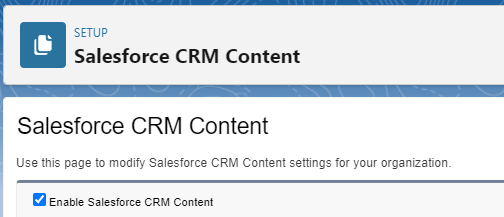
-
Give users access to Salesforce CRM Content by assigning feature licenses in one of the following ways:
-
To assign feature licenses to users automatically, from Setup, enter Salesforce CRM Content in the Quick Find box, select Salesforce CRM Content, and then select Autoassign feature licenses to existing and new users.

-
To assign feature licenses to users manually, from Setup, enter Users in the Quick Find box, then select Users and click Edit next to the user's name. Select the Salesforce CRM Content User checkbox and click Save.
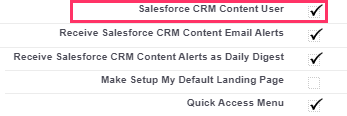
-
-
Verify that the Salesforce CRM Content users have the Salesforce CRM Content user permissions enabled. The user permissions include Manage Salesforce CRM Content, Create Libraries, Manage Content Permissions, Manage Content Properties, Manage record types and layouts for Files, and Deliver Uploaded Files and Personal Content. To add library items as email attachments, a user needs to be a member of the library.
Create Public Groups
-
In Salesforce Classic UI: In Setup, under Administration Setup -> Manage Users, select Public Groups.
-
In Salesforce Lightning UI: In Setup, under Users, select Public Groups.
Click New.
Type in a Label for the public group, the Group Name will be automatically populated. For example, there can be two groups named as "Dynamo End-users" or "Dynamo Administrators"
Grant Access Using Hierarchies does not work with Salesforce CRM Content, so having this checked depends on whether this public group is used for some other purposes also. If this is only used with Dynamo and Content Libraries, leave the checkbox unselected.
Add users to the public group. This can be done user by user, by roles, or by other public groups.
Click Save.
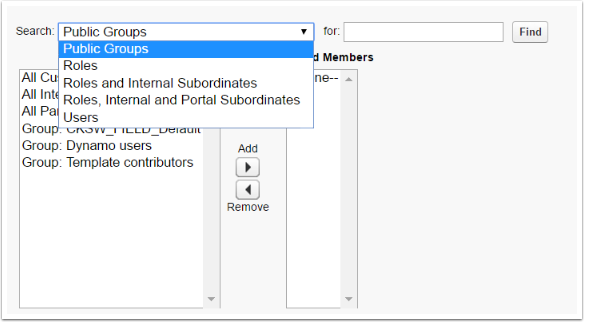
-
Add new users to an existing Public Group
-
In Salesforce Classic UI: In Setup, under Administration Setup -> Manage Users, select Public Groups.
-
In Salesforce Lightning UI: In Setup, under Users, select Public Groups.
Next to the appropriate public group, click Edit.
Add new users one by one, by roles or by other public groups.
Click Save.
Currently, managing Libraries is not available in Lightning Experience. All the creation and configuration need to be done in Classic UI. Nonetheless, all existing libraries and files in libraries will be visible in Lightning UI under Files tab.
-
Create a Salesforce Library to store Dynamo templates
-
Go to the File and then Libraries tab.
-
Under Libraries, click New Library.

-
Type the library's name in the Name field. For example: "Dynamo Templates"
-
Click Save.
-
Find the new library and using the drop-down menu, select Manage Members
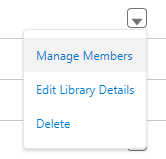
-
From the drop-down menu, select Public Groups. Select Dynamo Administrators and Dynamo Users public groups from the list, and click add.
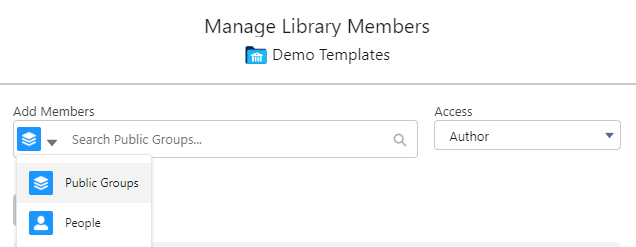
-
Grant at least Viewer permissions to those who will compose documents and at least Author permissions to those who will edit templates. For example:
-
Dynamo End-users: Viewer
-
Dynamo Administrators: Author
-
-
Click Save.

-
Add Dynamo template files to the Salesforce Library
There are 2 ways to add files to the Salesforce Library. Depends on the situation or the working process, select the appropriate method below
Upload template files to library using Dynamo
Under Dynamo tab in Office application or in Dynamo Online Editor, select Save or Save As
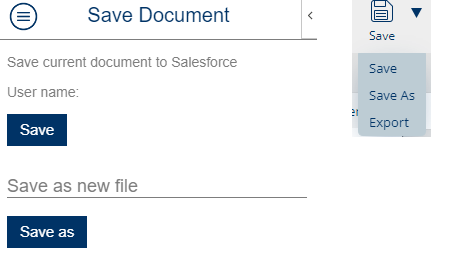
Under Share option, select Library.
Under Share with, select the desired Library
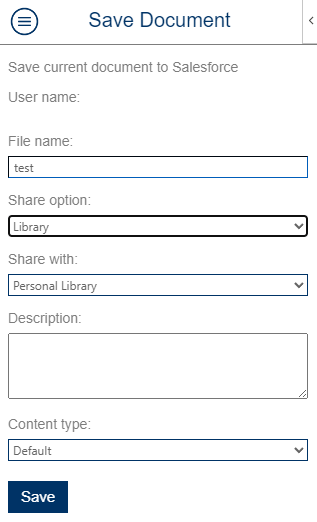
Click Save.
Upload files using Salesforce standard feature
In the Libraries tab, select the appropriate Library
In the Library, click on Add Files

Choose the Dynamo template file from the device.
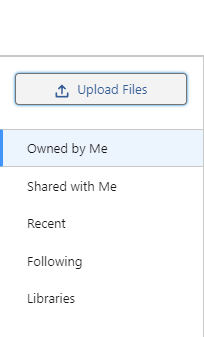
Select the file and click Done
(Optional) Create custom field and record type for Dynamo templates
A custom field and record type for Dynamo templates can be created. The custom field can look up for the specific object that has been using in Dynamo templates. As the result, the "Create" buttons can be configured: When end-users click the "Create" button in one Salesforce object to generate a new document, Dynamo will add filters to the template list:
-
Filter the list of templates by "Main Object": only those templates using that object as the "Main Object", instead of listing all Dynamo templates available in Salesforce.
-
Allow end-users to filter the list dynamically: a drop-down menu above the template list where end-users can filter the available templates based on fields such as Language, Country, for instance.
Best Practices:
-
The easiest way to manage Libraries' permissions in Salesforce CRM Content is through Public Groups. The recommended setting is to have at least one or two public groups, one for Dynamo End-users and one for Dynamo Administrators.
-
Create at least one Salesforce Library to store Dynamo template files. One or more libraries can be created for Dynamo templates, where the control to the users is controlled via public groups or user roles. For example, if there is 2 set of template lists for 2 different Business Units, 2 libraries can be created, in which only members of the Business Unit can access to the files:
-
Dynamo Templates BU1
-
Dynamo Templates BU2
-
-
Use record type and custom fields to give better descriptions of Dynamo template files. That will help in providing more filtering options in the future.
